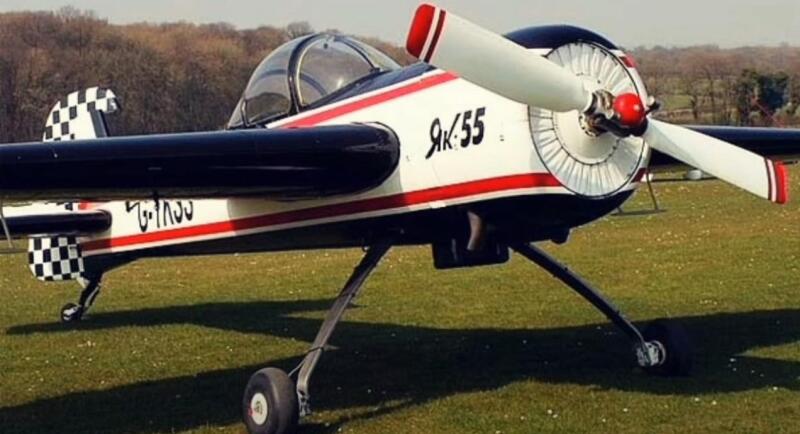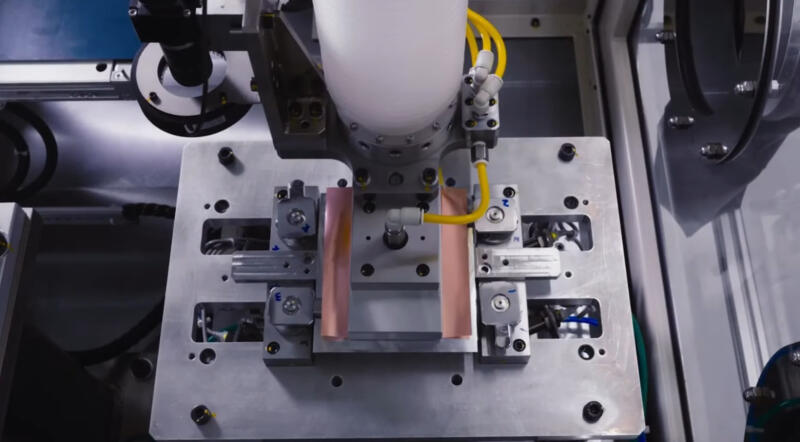To show your skills, according to the rules of international competitions, you need to fit into a limited space that had specific dimensions: 1000x900x800 meters. By 1979, the new Yak-55 aircraft was developed by the Yakovlev Design Bureau under the leadership of Yu. Yankevich.
 Requirements for performing aerobatics could change. Photo: YouTube.com
Requirements for performing aerobatics could change. Photo: YouTube.comWhen creating the vessel, new requirements were taken into account regarding the performance of aerobatic maneuvers in a "low-speed" style. For this, the wing was made thicker. As a result, the specific load on the plane decreased from 60 kg, as in the Yak-50, to 50 kg per 1 sq. m. The design turned out to be so successful that a patent was even issued for it.
In the 80s, this wing was successfully used on many foreign models of sports aircraft.
As a result, it became easier to perform all aerobatics, starting with the simplest ones and ending with a corkscrew “barrel”, “bell”, and other elements of vertical acrobatics. However, the Yak-55 was made for a long time: the first flight was made in May 81.
 When performing aerobatics, the ground can “turn out” to the side. Photo: YouTube.com
When performing aerobatics, the ground can “turn out” to the side. Photo: YouTube.comAnd then there was a discrepancy: over the past time, the “fashion trend” has changed: the pilots again began to practice high-speed style, which was previously called “Soviet”. It was used in competitions by the best pilots-athletes of that time: Americans, Czechs, French.
The solution
Not having time to get on the conveyor, the Yak-55 instantly became obsolete. But the aircraft had its advantages: it easily coped with any kind of spin and easily performed reverse aerobatics. “Only something” was required to increase the speed of the machine and ensure that it rotates around its longitudinal axis. This time, the designers did everything promptly: by the beginning of the next world championship in 1982, everything was ready, but not completely. The aircraft was tested right during the competition.
 Minuses turned into pluses after the championship. Photo: YouTube.com
Minuses turned into pluses after the championship. Photo: YouTube.comA number of identified shortcomings then had to be eliminated. In particular, they narrowed the wing, making it lighter. The result could be seen only in 1984, when the Russian pilot H. Makagonova received gold at the next World Championship, becoming the absolute champion. In some exercises, the first places were taken by Soviet athletes N. Nikityuk, V. Smolin. Another achievement belongs to Lyubov Nemkova, who became the world champion in 1986.
 Khalida Makagonova is the absolute world champion in 1984. Photo: YouTube.com
Khalida Makagonova is the absolute world champion in 1984. Photo: YouTube.comOf the foreign analogues of the Soviet "fifty-fifth", the Extra from Germany, the Pitts biplane, the Lazer aircraft (USA) and the Zlin car from Czechoslovakia stood out most strongly at that time. According to the FAI International Aviation Federation, over 1500 world achievements have been recorded in the light sport aircraft sector to date.
Design features of the Yak-55
In addition to the symmetrical wing, the aerodynamic scheme was also drawn up harmoniously in the car. The tail and horizontal tail, and the entire aircraft was "the same from all sides." The symmetry of the Yak-55 greatly facilitated the implementation of complex figures and simplified control.
Fuselage and landing gear
This is a classic semi-monocoque, wings with one spar, removable, equipped with ailerons at the rear, inside, in the root part - fuel tanks. The keel is made as a single unit with the aircraft body (to simplify the design). The chassis was borrowed from the Yak-50: it is non-retractable, the steering is the tail wheel.
 With such a chassis, it is best to take off on asphalt. Photo: YouTube.com
With such a chassis, it is best to take off on asphalt. Photo: YouTube.comA mechanical brake system is provided, the springs are made of titanium alloy.
Power point
The aircraft is equipped with a star-shaped nine-cylinder M-14P piston engine. The motor was developed by the designer Vedeneev already in 1947 on the basis of the predecessor AI-10. The next year, they were successfully tested and in 1950 the AI-14R (as it was then called) was put on the conveyor of the Voronezh Mechanical Plant. Later, all the developments on the engine were transferred to the OKB Motor Building Design Bureau, specially created at the enterprise.
 Schematic representation of the M-14P. Photo: YouTube.com
Schematic representation of the M-14P. Photo: YouTube.comThe first-born developed 260 "horses" and was installed on the Yak-12, Yak-18 and other aircraft, including Wilga. There was also a helicopter version of the engine for the Ka-15. The M-14P engine, which produced 360 hp. s., went into series only in 1974. In addition to the Yak-55, it was installed on the Yak-18T, Yak-50 and 52, as well as Aviatika. Main technical data of the Yak-55:
✅ wingspan, length, height - 9, 7,29 and 2,2 m
✅ empty weight and maximum takeoff - 550 and 875 kg
✅ top speed - 450 km/h
✅ ceiling - 4 km
✅ range - 495 km
✅ flight time - up to 2 hours
Separately, it is worth mentioning such a characteristic as the maximum allowable operating load. In the Yak-55, it was 9 units. Is it a lot or a little? For comparison: in conventional passenger aircraft, it does not exceed 2,5 units. For fighters, this figure is in the range from 6 to 9. Few aircraft can experience maximum overloads of 12 units. From Russian - Su-29, Su-31, foreign - Extra-300 and some other models.
 Checking the M-14P engine on a mobile stand. Photo: YouTube.com
Checking the M-14P engine on a mobile stand. Photo: YouTube.comThe air-cooled power unit is paired with a V-530TA-D35 propeller, which has a variable pitch. The power system (borrowed from the Yak-50) included a 5-liter supply tank (located under the floor), which made it possible to fly "upside down" for three minutes.
Who makes the engine?
Until 2007, the licensed version of the AI-14R was produced in Poland. China produced its own version of the AI-14P called the HS-6, and then the HS-6A with a capacity of 268 hp. With. True, whether the PRC had a production license from the USSR is unclear. In the Russian Federation, the serial production of this engine was stopped in 1994.
Romania has been producing the M-1983P since 14 and produced them at least until 2019, including its own modification under the M-14D index.
In 2018, the rights of the developer in Russia for the production of M-14PF and R engines, as well as M-14V26V1, were assigned to the Experimental Design Bureau of Motor Building. Here is such a mess with the engine: apparently, the design turned out to be successful if they are produced in different countries.
Flight equipment
It is a minimum set of equipment and instruments that allows you to fly only in simple weather conditions. There is a radio station on board.
 A minimum of devices does not interfere with winning world championships. Photo: YouTube.com
A minimum of devices does not interfere with winning world championships. Photo: YouTube.comActually, more is not required: the machine is designed for competition.
Production of the Yak-55
The aircraft, simple in design, easy to maintain, with high flight characteristics, was put on the conveyor in 1985 (Progress aviation enterprise in Arsenyev). Until 1991, 108 pieces of equipment were produced. However, later they decided to resume production, and until 1993 another 106 machines “saw the light”, that is, a total of 214 devices. Here is an example of the continuation of serial production in the conditions of the most severe economic crisis of the 90s and the collapse of the USSR.
Machine versions
The prototype was made in the amount of two copies. Later, a pre-production basic version was developed, which differed from its predecessors in a sharp-nosed wing (its profile was changed). The next modification - the Yak-55M had a smaller wingspan. On its basis, the Yak-54 was built, which was used to train future pilots. The plane can still be found in some flying clubs today.










